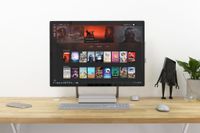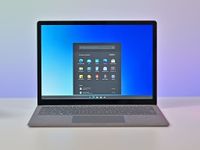Source: Windows Central
It’s been a full two years since I wrote about how Linux is now a viable OS for PC gaming and in that time a lot has changed. The open-source desktop OS isn’t just for gaming. It’s also great for a bunch of other computing tasks one usually does on Windows or even macOS. After using Windows for more than two decades, I find myself no longer able to put up with it.
Windows XP was the glory days of Microsoft’s OS. I wouldn’t be able to guess the number of hours spent in IRC apps and games like Unreal Tournament 99/2004 with friends. Then came Windows Vista and it was a hot mess with hardware being nowhere near ready to run such a package. Windows 7 changed the game and was unfortunately followed by Windows 8.
Windows 10 wasn’t terrible and remained my go-to OS for gaming, but that’s changed over the last two years with the advancements made to Valve’s Proton compatibility layer. I can now pretty much do everything on Linux I could with Windows and that forced Microsoft’s OS to take a backseat in 2021 on my main PC.
There’s so much freedom
 Source: Rich Edmonds / Windows Central
Source: Rich Edmonds / Windows Central
One of the most enticing parts of Linux is choice. Even down to the distribution (or distro) you’d prefer to use, be it Ubuntu, Arch, or Manjaro. There’s a distro for everyone and even after choosing one, it’s possible to customize it to your heart’s content. Don’t like the new snap package manager in Ubuntu? Go ahead and completely remove it with a few Terminal commands.
Using Linux day-to-day with the latest distros is nothing but a joy.
It’s incredibly user-friendly too. You could install a distro like Linux Mint that attempts to replicate the look and feel of Windows and help bridge the gap between the two platforms. Once up and running (which takes around 5 minutes) you’re good to go. There aren’t any pop-ups asking for the OS to send data to servers, nor will you have to accept targeted advertising.
Using Linux day-to-day with the latest distros is nothing but a joy. Everything just works out of the box. Some distros can even come with the latest drives from NVIDIA already included, but it’s just as easy to install them on other distros. There are some software suites that aren’t supported on Linux, but there are plenty of alternatives and are usually free of charge.
Want to use Microsoft Office? There’s Libre Office ready to go. Fan of Adobe Photoshop? GIMP is your new best friend. The most popular apps like Slack, Discord, Chrome, Microsoft Edge, Thunderbird, Steam, VLC player, Plex, and more are all available for Linux. Some distros even have an app store that can handle installing and updating each app.
Valve’s Proton is literal software magic
 Source: Windows Central
Source: Windows Central
Proton is Valve’s answer to getting more people to use Linux for gaming. It’s a compatibility layer that works with other open-source tools to make Windows games run on Linux. I noted in my previous gaming on Linux piece that performance in games was usually behind Windows, but this isn’t the case in more and more PC titles.
Even when using Proton, you can often find performance on par with what you’d find with a Microsoft-powered PC. The best part is the whole process of downloading, installing, and playing Windows games on Linux is as straightforward as Microsoft’s OS. Proton works with WINE and DXVK, among others, and everything is handled by the Steam client.
ProtonDB is a website that tracks how well games perform using Proton on Linux. The list of supported games that run at least well enough to play is constantly growing with each update. Even the likes of Mount & Blade II: Bannerlord runs exceptionally well, aside from a minor stutter here and there.
 Source: Windows Central
Source: Windows Central
Online games that make use of anti-cheat software didn’t play ball with Proton, but Valve has been working with the developers to add support for its set of tools. Now, you can install and enjoy games that use tools like BattleEye and not need to fire up a Windows install to just play one game every so often.
Microsoft still doesn’t quite know how to approach PC gaming. After what happened with Windows Live and the still mediocre Microsoft Store, Steam and other distribution platforms are where gamers flock to. Linux is only going to get better with each community-driven release and distro maintainers are working hard to improve the user experience to entice more people to make the switch.
Gaming is no longer one of those reasons to choose Windows over Linux unless it’s a specific game that simply isn’t native or supported by tools like Proton.
Windows 11 became a living nightmare
 Source: Windows Central
Source: Windows Central
I’m a fan of what Microsoft finally brought to the desktop with Windows 11. Our resident Windows expert Zac Bowden gave the OS a positive score in his incredible in-depth review and I agree with the majority of what was written. Where Windows 11 falls flat for me, however, is with the installation process. It’s an absolute mess.
I have a few test rigs configured for various PC components we review here at Windows Central and installing fresh copies of Windows for Intel’s 12th Gen launch was riddled with issues from the get-go. The installer would either refuse to load or fail to see drives. In fact, one install required a 2.5-inch SATA SSD to be connected to the board in order for Windows 11 to successfully boot from the M.2 NVMe drive.
Interestingly, I never had an issue with the latest security measures that require trusted platform modules (or TPM) since most motherboards and processors released in the past few years support it out of the box. It was more Windows having trouble with SSDs, sometimes even outright refusing to install Windows on specific drives.
For a laugh, I installed Linux Mint on all the machines and didn’t see a single problem. Not one. This is a billion-dollar company going up against average Joe and losing in my anecdotal experiences.
But Windows isn’t completely out of my life. I still use it regularly to remain in the loop with all the latest news and because we continue to benchmark products using the OS. For my main PC, Windows isn’t even installed on a secondary drive anymore.

Microsoft, we need to talk about the Xbox app on PC
Microsoft’s PC Game Pass service is great. But as the publisher looks to expand on its PC gaming foundations, it’s clear that the current state of the Xbox app just isn’t cutting it.

Here’s what Microsoft killed off in 2021
Microsoft ended support for quite a few products and services this year. From gaming to productivity, here are the most noteworthy things that Microsoft killed off in 2021.

Be the first to comment